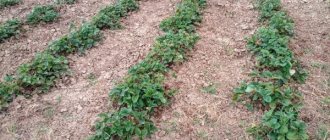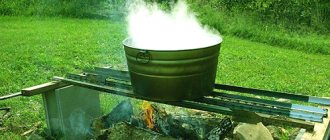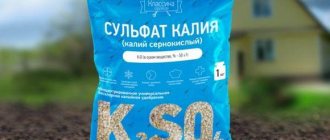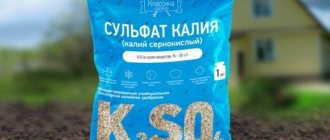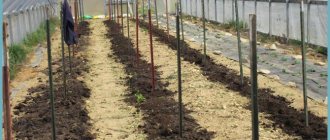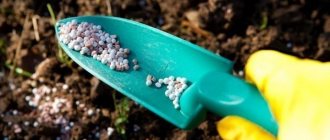Peony is considered an unpretentious plant, but despite this it needs to be fed periodically to ensure full growth and abundant flowering. To know how to feed peonies correctly and with what, you should familiarize yourself with the general rules for applying fertilizers that are suitable for this ornamental plant.
- 2 Fertilizing schemes depending on the time of year
2.1 In spring2.1.1 Video: features of spring feeding
- 2.2.1 Video: what fertilizers do peonies require after flowering
- 2.3.1 Video: feeding peonies before wintering
How to feed peonies after winter in early spring?
In order for peonies to please the eye and serve as a decoration for the front garden, today we will look at how and when to care for them, as well as what and how to feed them correctly.
- The peony itself is quite unpretentious and resilient, if, of course, all measures for proper planting are followed and the location is chosen well
- This crop is quite hardy and tolerates both persistent frost and heat.
- On the roots of peonies there are many dormant buds that change all the time. You should not try to “transfer” the plant from one place to another. With the right place, a crop can remain and bloom for up to fifty years in the allotted time, and there are cases even longer. For such favor, gardeners adore them and never stop caring for them.
However, in order for these flowers to please your eye, it is not enough to plant them on the site; it is also necessary to create favorable conditions for them, namely:
- Eliminate weeds to allow stems to emerge
- Water and loosen the soil
- Fertilize the crop with various fertilizers and other necessary additives
- Prevent the occurrence of diseases
It is important to feed peonies.
Caring for the crop in the spring is not difficult, but it has a number of its own features and characteristics. It must be said right away that not only fertilizing is important during this period, it is also very important to provide proper care for peonies and only after that start fertilizing them.
- The above-ground part of the plant dies before the onset of cold weather, and in the spring the shoots grow again
- Weeds must be eradicated immediately so that they do not affect the growth of new stems. The soil around the bushes must be loosened very carefully, at least 12 cm from the bush, otherwise you can harm the sprouts that are trying to break through.
- It is necessary to try to rake the soil towards the plant, while ensuring protection of the root system with the necessary layer of soil within 5 cm. This arrangement of the rhizome must be constantly monitored so that it does not rise above the soil. If the root nevertheless rises above the surface, then the growing buds will suffer from cold or heat and as a result will die
As soon as the snow melts, usually in early spring, during the period when small shoots begin to emerge from the ground, the plant bushes must be fed with the following nutrients:
- Nitrogen
- Phosphorus
- Potassium
- Microelements
- Potassium permanganate solution
- Ammonium nitrate
Indeed, if the plant’s bushes are untimely and insufficiently fed in early spring, it will not receive enough of the nutrients it needs and will lag behind in development and be prone to disease.
What peonies love and what they shouldn’t use
Below you will find information about what peonies like and what to feed them.
| Variety | Examples |
| Nitrogen | As nitrogen fertilizers, solutions of urea or ammonium nitrate are applied under flowers in early spring. Among the organic fertilizers suitable for peony are horse manure (it does not burn the roots and can be used as mulch), mullein and chicken droppings. |
| Mineral | For peony, ready-made mixtures of mineral fertilizers are used. The following preparations are widely known among gardeners:
The composition of these mixtures, in addition to the main elements, also includes microadditives that affect the splendor of flowering. |
Do not use:
- pig manure, because of its causticity;
- substances that acidify the soil (peat, pine litter, ammonium chloride).
Vermicompost
Separately, it is worth mentioning vermicompost, a product of the processing of organic matter by red dung worms. This is an environmentally friendly and natural substance that significantly strengthens the plant’s immunity.
- Fertilizer in dry form is applied directly under each peony bush in spring and autumn.
- A liquid extract from vermicompost is used for foliar feeding of flowering peony, diluting 15 ml of the drug in 1 liter of water.
Fertilizing peony with bread
A cheap and effective fertilizer for perennials, ensuring active growth of stems and lush flowering.
Pieces of bread - white, rye, yeast sweet baked goods, crackers - are suitable for preparing fertilizer. About a kilogram of product is placed in a bucket and filled with hot water (about 50 degrees). Cover the container with a lid and leave it overnight or for a day.
The plants are watered with the strained solution twice a season: in the spring, when the green mass is actively growing, and before the peony blooms. About 5 liters of product are used for an adult peony bush.
How to feed peonies in the spring during budding?
As you can see, these flowers constantly need regular feeding, and the period of formation of plant buds is no exception. It is very important to fertilize the bushes of these plants at this time, because after the winter period, peonies, like all plants, are very weakened and need to be replenished. Consequently, in this case it is impossible to do without fertilizing, so it is unacceptable to skip the application of fertilizers that improve the budding of the crop.
In order for peony bushes to delight with lush and rich flowering for a long time, it is necessary to remove all the buds for the first couple of years after planting them in the ground. This technique will allow the plant to take root firmly and develop in the best possible way in the future.
Feeding during budding
So, during the active budding of flowers, you should give preference to the following substances:
- Initially, you should give preference to fertilizers that contain nitrogen and potassium.
- Specifically, during the budding period, peonies must be fertilized with a mixture of nitrogen, phosphorus and potassium
- After the plant has flowered, you can limit yourself to adding substances such as phosphorus and potassium.
Rules for fertilizing
Regardless of the elements used for feeding, there are several rules for their implementation.
Root feeding
Root feeding is applied directly to the soil. Nutrients dissolve in the soil, the solution is absorbed by the roots. Right:
- Apply fertilizer only after watering, in moist soil;
- embed dry fertilizer granules by loosening to a depth of 3-5 cm;
- After watering with a nutrient solution, mulch the soil.
Wrong:
- apply fertilizer to dry soil;
- sprinkle granules or pour the solution into one point, and do not distribute it around the bush.
Foliar feeding
It is carried out by spraying on the leaf. The concentration of the substance in the solution is always half as much as when feeding the peony at the root. Correctly apply fertilizer on the leaf:
- spray the plant in the evening or in cloudy weather to avoid burns on the leaves;
- Do not get the solution on buds or open flowers.
Autumn feeding of peonies, for the winter - fertilizers, folk remedies: rules, recipes and technologies
In addition to fertilizing, which is carried out during the most highly intensive stages of plant development, an important place is given to autumn. In the autumn season, somewhere in September, early October, plant roots also continue to grow, while accumulating in their individual compactions nutritional elements that are very important for overcoming the winter period and spring germination. For this reason, autumn fertilizing of the crop should not be skipped.
You can use the following feeding products. To prepare phosphorus-potassium fertilizer you need to prepare:
- 17 g phosphorus
- 17 g potassium
- A bucket of water
Pour the liquid into the container and add our fertilizers to it. We carefully water each bush with the resulting mixture, avoiding getting it on the stems and leaves of the flower, in order to avoid dangerous burns that weaken the general condition of the plant.
Final feeding of peonies is carried out using a mixture of the following products:
- 100 g bone meal
- 1 cup wood ash
The resulting mixture must be spread in an even layer around each bush of the plant and the soil must be loosened, so that the resulting fertilizer will penetrate into the right place. Here's another useful tool. This nutritious fertilizer for peonies can be prepared using a fairly accessible and simple method:
- In a prepared barrel you need to dilute a bucket of mullein with 5 buckets of water
- Next, place the resulting mixture in sunlight and let it brew for 2 weeks.
Fertilizing peonies before winter
At this time, you need to do the following manipulations with fertilizer:
- wait for active fermentation
- add 50 g of wood ash to the barrel
- 200 g superphosphate
- to stir thoroughly
- Before watering, dilute the resulting mixture with ordinary water.
In addition to feeding flowers in the autumn, it is equally important to create good conditions for them to winter:
- When the outside air temperature rapidly drops, the crop is exposed to unfavorable weather conditions, therefore, it is important to create the most comfortable conditions in which the plant will remain until spring. The most important conditions for a good immersion of a peony in sleep are pruning the bush and creating a shelter for the peony.
- This procedure should be carried out in the last month of autumn, with the first frosts. Pruning bushes means almost completely removing the stems. Only small shoots above the buds are left above the ground. You can use fallen leaves, humus, or peat as shelter. In addition, such a layer should reach from 10 to 20 centimeters, depending on how cold the winters are.
- Thanks to this manipulation, the plants will be protected from frost and provided with the necessary elements for hibernation. When sprinkling bushes, preference should not be given to straw and wood shavings. Indeed, under such a thickness, the formation of fungi and bacteria is possible. Throughout the winter, keep an eye on the peony bushes; sometimes the buds become bare. If this happens, cover the shoots immediately. And when spring comes, the seedlings will need to be freed from the improvised “blanket”.
In order for peonies to be healthy and delight your eye with their lush, luxurious blooms, it is vitally important to take care of them on time, efficiently, and, following all instructions and recommendations.
Which is better: natural organic matter or mineral fertilizers?
Peony responds with gratitude to both mineral fertilizers and natural organic matter.
Mineral fertilizers may contain one macroelement or be complex. The latter are the best option, since the specific need of peonies for macro- and microelements is taken into account; they are included in the composition in the required proportion. The most popular products are Kemira, Ideal, Mortar. But no one forbids mixing monofertilizers. Fertilizers are available in the form of granules, powders, tablets, and liquids.
Peonies can be fed with both complex mineral fertilizers and those containing one or more macroelements
Organic matter is necessary to maintain soil fertility and improve the quality of the substrate. This is a whole “cocktail” of nutrients. In autumn, it is also useful for protection from frost - decomposing humus and compost release heat. In addition to humus and compost, infusions of nettle leaves, chicken droppings and cow manure, eggshells, yeast, bread kvass, commercial fertilizers based on humates (Baikal EM-1) are also suitable for peonies.
Humus is a natural remedy for maintaining and restoring soil fertility
Basic information
Almost everyone knows that peony is a rather unpretentious plant that does not need special attention. To make it more resistant to cold and increase the possibility of lush flowering, it is enough to use several simple agricultural techniques.
To begin with, you should prepare the soil in time, saturating its composition with useful microelements. Loose soil of high fertility is ideal for these purposes. When planting a peony, you need to dig a fairly deep hole, the bottom of which is lined with a mixture of humus and bone meal. The indicated compound can be replaced with peat and superphosphate. If we are talking about planting a bush in clay soil, you will first have to loosen it with sand. When the soil is filled correctly, over the next few years the peonies will not need additional feeding.
In order for the bush to grow large and powerful, the buds that appear on it should be cut off for several seasons in a row. This way the plant will use all its strength to develop a powerful root system.
Common mistakes
- Watering liquid fertilizer into the center of the bush. Feeding peonies is similar to feeding trees. Nutrient compositions are poured not under the trunk (in this case, the stems), but into the circle around the trunk. Watering into the center of the bush can cause chemical burns.
- Frequent use of the same fertilizers. Each component of the fertilizer plays its role. Nitrogen is needed during the first stages of spring growth. Next, potassium and phosphorus fertilizers, as well as complex formulations, are used. Do not change the order of fertilizer application.
- Using solutions with high concentrations of the active substance for young plants. Excess nutrition is always harmful to plants. They begin to get sick and become vulnerable to diseases and parasites.
- Use of urea during bud formation and flowering. When, after the first application of urea in early spring, the bush begins to quickly turn green and gain strength, the temptation is high to use such an effective remedy again. But, in fact, nitrogen will only make things worse in the future.
Preparation of planting material
The best cuttings for planting are those that have 3-5 renewal buds and the same number of roots.
For better rooting of the plant, it is recommended to shorten the roots to 10 cm.
You may have a question, why should there be the same number of buds and roots?
The whole point is that if there are a lot of buds in the division and few roots, then in the spring the stems that grew from these buds will not have enough nutrition. After all, until new roots have formed, the young plant receives nutrients from the old roots.
If the opposite happens - there are few buds and many roots, then the plant in the first year (and the next) may not develop new buds, but be content with the existing ones, which will undoubtedly affect the flowering of the bush.
So I advise you to pay attention to the fact that on the cuttings that you are going to plant, the number of renewal buds and roots is the same.
Before planting, we carefully inspect the planting material and very carefully trim all rotten and damaged tissue to healthy parts.
Then, for disinfection, you should hold the roots in a solution of potassium permanganate (7-10 g per 10 liters of water) or copper sulfate (100 g per 10 liters of water) and sprinkle the wounds with crushed charcoal.
You can also improve rooting using the following procedure: dip the roots in a clay mash, then lightly dry them and plant.
We make the mash in this way: dissolve 60 g of copper sulfate, 2 tablets of heteroauxin and 5 kg of clay in 10 liters of water, and you can also add 500 g of wood ash.
Another advantage of this processing is that planting material can be stored much longer, and it can also be sent by mail.
